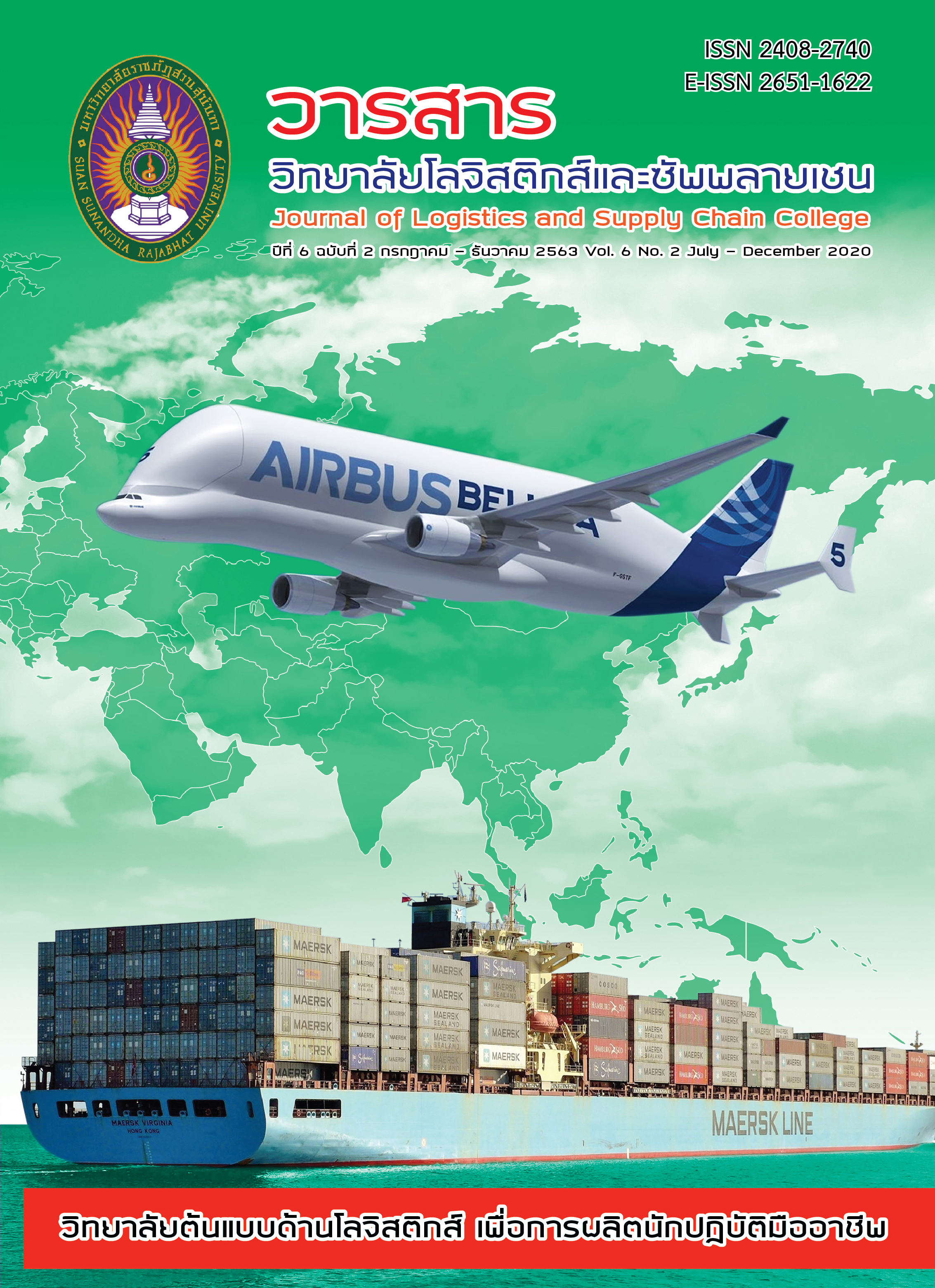Logistics Management for Tourist Attraction in Nakhon Pathom province in Thailand
Abstract
The objective of this research were 1) to study the influence of tourist attraction that affects the logistics information flow in tourism, Nakhon Pathom province, Thailand 2) to study the influence of tourist attraction that affects logistics physical flow in tourism, Nakhon Pathom province, Thailand 3) to study the influence of Logistics Information Flow that affects Logistics Customer Service Flow in Tourism, Nakhon Pathom province, Thailand 4) to study the influence of Logistics Physical Flow that affects Logistics Customer Service Flow in Tourism, Nakhon Pathom province, Thailand, and 5) to study the influence of Logistics Customer Service Flow that affects Repeat Tourist in Tourism, Nakhon Pathom province, Thailand. A sample size was 320 people. The research instrument was a questionnaire. The statistics used for data analysis were frequency, percentage, mean and standard deviation. For the statistics used to test the hypothesis, the researcher used the harmonic index consisting of chi-square, GFI, RMSEA and CFI. And the results of the verification were consistent with the empirical data. The results of the data analysis showed that the Chi-square was 16.00 with the P-Value of 0.84 and the CFI was 1.00. GFI was 0.96 and RMSEA was 0.030. The results found that The results of the study showed that the results of the 1) tourist attraction influence on the logistics information flow 2) tourist attraction influence on the logistics physical flow 3) logistics Information Flow influence on the Logistics Customer Service Flow 4) Logistics Physical Flow influence on Logistics Customer Service Flow and 5) Logistics Customer Service Flow influence on Repeat Tourist. The results of this research will benefit tourism. Both in terms of tourist attractions Information about tourism products and services and marketing keeps Repeat Tourist.
References
กรมการท่องเที่ยว. (2560). แผนยุทธศาสตร์การพัฒนาแหล่งท่องเที่ยวของประเทศ พ.ศ. 2560-2564. พิมพ์ครั้งที่ 1. กรุงเทพฯ: พีดับบลิว ปริ้นติ้ง.
กรมการท่องเที่ยว. (2562). ข้อมูลนักท่องเที่ยว . ค้นเมื่อ 20 สิงหาคม 2562, จาก: http://www.tourism.go.th/view/.
คมสัน สุริยะ. (2551). กรอบแนวคิดโลจิสติกส์สำหรับการท่องเที่ยว. ค้นเมื่อ 25 พฤษภาคม 2562, จาก: http://www.tourismlogistics.com.
ชญานันท์ เกิดพิทักษ์, ชัยฤทธิ์ ทองรอด, นิฤมล มณีสว่างวงศ์ และมนตรี จังธนสมบัติ. (2562). ผลกระทบของการจัดการโลจิสติกส์เชิงบูรณาการที่ผลต่อความสามารถทางการตลาดในธุรกิจการท่องเที่ยวที่มีศักยภาพสูง. วารสารวิทยาลัยโลจิสติกส์และซัพพลายเชน, 5(1),99-113.
เถกิงศักดิ์ ชัยชาญ. (2555). การจัดการโลจิสติกส์สำหรับการท่องเที่ยวในอำเภอวังน้ำเขียวจังหวัด
นครราชสีมา. วารสารเทคโนโลยีสุรนารี, 6(2), 17-33
วาสนา จรูญศรีโชติกำจร, สุภาภรณ์ หมั่นหา, การันต์ เจริญสุวรรณ, กนิษฐา ศรีภิรมย์, วรางค์ รามบุตร และชลธิชา แสงงาม. (2560). ประสิทธิภาพของการจัดการโลจิสติกส์ของแหล่งท่องเที่ยวจังหวัดกำแพงเพชร. วารสารวิทยาการจัดการสมัยใหม่, 10(2), 213-229.
สำนักงานการท่องเที่ยวและกีฬาจังหวัดนครปฐม. (2560). ข้อมูลนักท่องเที่ยว. ค้นเมื่อ 25 พฤษภาคม 2562 จาก: https://nakhonpathom.mots.go.th/index.php.
สุภัสสรา ปัญโญรัฐโรจน์. (2561). การจัดการโลจิสติกส์สำหรับการท่องเที่ยวในจังหวัดนนทบุรี. วารสารมนุษยศาสตร์และสังคมศาสตร์ มหาวิทยาลัยราชพฤกษ์, 4(Supplement), 151-161
Cronbach, L. J. (1984). Essential of psychology testing. New York: Harper.
Gursoy, D., & McCleary, K. (2004). An integrative model of tourists' information search behavior. Annals of Tourism Research, 31(2), 353-373.
Hair, J. F., Black, W. C., Babin, B. J., Anderson, R. E., & Tatham, R. L. (2006). Multivariate data analysis (6th ed.). Uppersaddle River: Pearson Prentice Hall. European Business Review, 20(4), 298-314.
John Magan, Chandra Lalwani & Tim Butchor. (2008). Chapter 9 Information flows and Technology. Global logistics and Supply Chain Management. Page 150.
Kline, R. B. (2011). Methodology in the Social Sciences. Principles and practice of structural equation modeling (3rd ed.). Guilford Press. Analysis. 6th ed. Upper Saddle River, N.J. : Pearson Education Inc.
Likert R. (1967). The Human Organization: Its Management and Value. New York: McGraw-Hill company.
McIntosh, R., Goeldner, C. R., & Ritchie, B. J. (2007). Tourism: principles, practice and Philosophies. 7th ed. New York: Johm Wiley & Sons.
Osti, L., Disegna, M., & Brida, J.G. (2012). Repeat visits and intentions to revisit a sporting event and its nearby destinations. Journal of Vacation Marketing, 18(1), 31-42.
Panayides, P. M. (2007). The impact of organizational learning on relationship orientation, logistics service effectiveness and performance. Industrial Marketing Management, 36(1), 68–80.
Panyorattaroj, S. (2018). Logistics Management for Tourism in Nonthaburi Province. Journal of Humanities and Social Sciences Rajapruk University, 4(Supplement), 151–161.
Pimonratanakan, Sudarat & Ayasanond, Chitpong. (2018). The Supply Chain Management of Pomleo Production Processes and Tourism Sustainability in Nakhon Chaisri, Nakhon Pathom Province, Thailand. African Journal of Hospitality, Tourism and Leisure, 7(5).
Qing Zhang. (2008). Essentials for Information Coordination in Supply Chain Systems. Asian Social Science, 4(10), 57.
Riikka Kaipia. (2007). Supply Chain coordination – study on planning and information sharing mechanism. Helsinki University of Technology, Laboratory of Industry management, Doctoral dissertation series 2007/2. Espoo 2007.
Untong,Akarapong. (2008). Integrated development of sustainable tourism for the Greater Mekong Sub-region 2007: a comparison of GMS logistics systems, Master’s thesis.Chiang Mai University.
Zeithaml, V.A. & Bitner, M.J. (1996). Services Marketing. McGraw-Hill, New York



